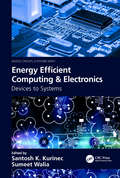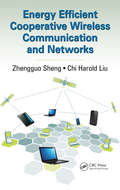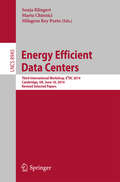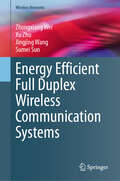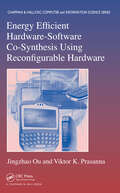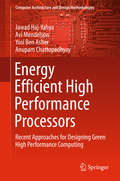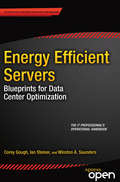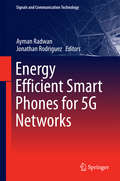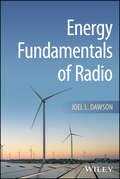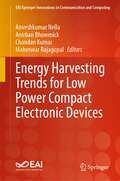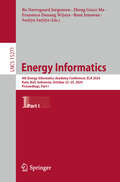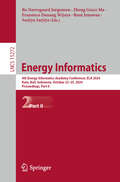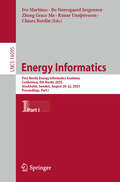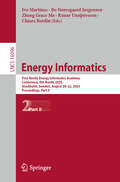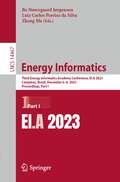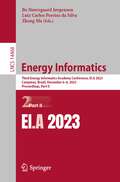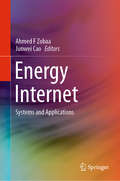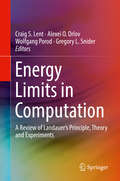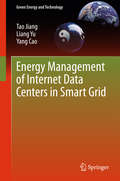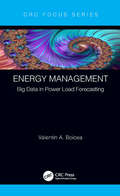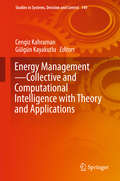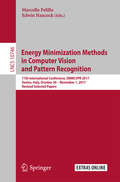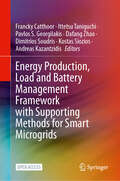- Table View
- List View
Energy Efficient Computing & Electronics: Devices to Systems (Devices, Circuits, and Systems)
by Krzysztof Iniewski, Santosh K. Kurinec and Sumeet WaliaIn our abundant computing infrastructure, performance improvements across most all application spaces are now severely limited by the energy dissipation involved in processing, storing, and moving data. The exponential increase in the volume of data to be handled by our computational infrastructure is driven in large part by unstructured data from countless sources. This book explores revolutionary device concepts, associated circuits, and architectures that will greatly extend the practical engineering limits of energy-efficient computation from device to circuit to system level. With chapters written by international experts in their corresponding field, the text investigates new approaches to lower energy requirements in computing. Features • Has a comprehensive coverage of various technologies • Written by international experts in their corresponding field • Covers revolutionary concepts at the device, circuit, and system levels
Energy Efficient Cooperative Wireless Communication and Networks
by Zhengguo Sheng Chi Harold LiuCompared with conventional communications, cooperative communication allows multiple users in a wireless network to coordinate their packet transmissions and share each other's resources, thus achieving high-performance gain and better service coverage and reliability. Energy Efficient Cooperative Wireless Communication and Networks provides a comp
Energy Efficient Data Centers
by Sonja Klingert Marta Chinnici Milagros Rey PortoThis book constitutes the thoroughly refereed post-conference proceedings of the Third International Workshop on Energy Efficient Data Centers, E2DC 2014, held in Cambridge, UK, in June 2014. The 10 revised full papers presented were carefully selected from numerous submissions. They are organized in three topical sections named: energy optimization algorithms and models, the future role of data centres in Europe and energy efficiency metrics for data centres.
Energy Efficient Full Duplex Wireless Communication Systems (Wireless Networks)
by Xu Zhu Jingjing Wang Zhongxiang Wei Sumei SunIn an effort to overcome the spectral efficiency loss and high latency by half-duplex (HD), full-duplex (FD) has attracted extensive attention in industry and academia. With signal transmitted and received simultaneously over the same frequency, FD can approximately double the SE over HD. More than that, by enabling the capability of simultaneous transmission-and-reception for communication nodes, full duplex (FD) is a key enabler for many 5G techniques, including but not limited to integrated sensing and communication, low-latency relaying, concurrent bi-directional uplink and downlink transmission, ect. Nevertheless, in FD communications, both transmit and receive radio frequency (RF) chains are activated for exchanging data, and additional power is triggered by self-interference cancellation. As FD requires much higher power consumption than that of half duplex (HD), it is against the green evolution requirement proposed by the future communication systems. To address the critical high-power challenge in applying FD communications, this book will introduce the fundamentals and algorithm designs for energy-efficient FD design. This book will first discuss the principle of energy-efficient communications, which aims to make a good balance between communication performance and system energy consumption. Then, this book will discuss different self-interference cancellation schemes, including passive suppression, analogue cancellation and digital cancellation for FD communications, from the prospective of energy efficiency. Subsequently, this book will present some edge-cutting energy efficiency-oriented FD solutions, including adaptive transmission power adaptation, wireless power transfer FD relaying, bi-directional FD distributed antenna systems, from the perspective of algorithm design and performance analysis.
Energy Efficient Hardware-Software Co-Synthesis Using Reconfigurable Hardware (Chapman & Hall/CRC Computer and Information Science Series)
by Viktor K. Prasanna Jingzhao OuRapid energy estimation for energy efficient applications using field-programmable gate arrays (FPGAs) remains a challenging research topic. Energy dissipation and efficiency have prevented the widespread use of FPGA devices in embedded systems. Helping overcome these challenges, this book offers solutions for the development of energy efficient applications using FPGAs. It provides a framework for high-level hardware-software application development, describes energy performance modeling for reconfigurable system-on-chip devices, and explores energy efficient designs for various applications. The authors present a two-step rapid energy estimation technique that enables high-level design space exploration and offer a hardware-software design for energy efficient implementations of operating systems.
Energy Efficient High Performance Processors: Recent Approaches For Designing Green High Performance Computing (Computer Architecture and Design Methodologies)
by Anupam Chattopadhyay Jawad Haj-Yahya Avi Mendelson Yosi Ben AsherThis book explores energy efficiency techniques for high-performance computing (HPC) systems using power-management methods. Adopting a step-by-step approach, it describes power-management flows, algorithms and mechanism that are employed in modern processors such as Intel Sandy Bridge, Haswell, Skylake and other architectures (e.g. ARM). Further, it includes practical examples and recent studies demonstrating how modem processors dynamically manage wide power ranges, from a few milliwatts in the lowest idle power state, to tens of watts in turbo state. Moreover, the book explains how thermal and power deliveries are managed in the context this huge power range. The book also discusses the different metrics for energy efficiency, presents several methods and applications of the power and energy estimation, and shows how by using innovative power estimation methods and new algorithms modern processors are able to optimize metrics such as power, energy, and performance. Different power estimation tools are presented, including tools that break down the power consumption of modern processors at sub-processor core/thread granularity. The book also investigates software, firmware and hardware coordination methods of reducing power consumption, for example a compiler-assisted power management method to overcome power excursions. Lastly, it examines firmware algorithms for dynamic cache resizing and dynamic voltage and frequency scaling (DVFS) for memory sub-systems.
Energy Efficient Servers: Blueprints for Data Center Optimization
by Corey Gough Ian Steiner Winston SaundersEnergy Efficient Servers: Blueprints for Data Center Optimization introduces engineers and IT professionals to the power management technologies and techniques used in energy efficient servers. The book includes a deep examination of different features used in processors, memory, interconnects, I/O devices, and other platform components. It outlines the power and performance impact of these features and the role firmware and software play in initialization and control. Using examples from cloud, HPC, and enterprise environments, the book demonstrates how various power management technologies are utilized across a range of server utilization. It teaches the reader how to monitor, analyze, and optimize their environment to best suit their needs. It shares optimization techniques used by data center administrators and system optimization experts at the world's most advanced data centers. What you'll learn * Develop a deep understanding of power management in modern servers - from data center and systems software to low-level processor technologies - and all the pieces in-between. * Build an understanding of technologies used in cores, caches, memory, system agents, processor interconnects, and PCI-E to manage power. * Learn techniques for monitoring and characterizing server power management technologies including component and system level impact. * Develop strategies to improve infrastructure utilization and cost-effectiveness, to guide configuration and purchasing decisions, and to enhance application deployment. * Learn new techniques to optimize a server for energy efficiency while still meeting the service level requirements of software, related systems in the data center, and end customers. Who this book is for Primarily: Engineers and IT professionals. More broadly, the book appeals to a wide technologist audience - anyone who designs or relies on a server to run services and applications - from software engineers, to system administrators, to equipment and system manufacturers, to data center operators. Table of Contents Foreword/Preface Chapter 1: Why Data Center Efficiency Matters Chapter 2: CPU and Memory Power Management Chapter 3: Memory and I/O Power Management Chapter 4: Software Architecture Chapter 5: BIOS and Management Firmware Chapter 6: Operating Systems Chapter 7: Monitoring Chapter 8: Characterization and Optimization Chapter 9: Data Center Management Chapter 10: Terms and Technology Appendix
Energy Efficient Smart Phones for 5G Networks
by Jonathan Rodriguez Ayman RadwanThis book addresses current technology trends and requirements leading towards the next era in mobile communication handsets; and beyond that the book proposes innovative solutions that could be candidate solutions for 5G phones. It adopts a multidisciplinary and interdisciplinary stance towards handset design, a necessary ingredient if 5th Generation handset and services are to really take-off. Therefore the scope of the book targets a broad range of subjects, including energy efficiency, RF design, cooperation, context-aware systems, roaming, and short-range networking, all of which working in synergy to provide seamless mobility and high speed connectivity within a HetNet environment. Specifically, the authors investigate how we can exploit the cooperation paradigm and context-aware mechanism working in synergy to provide energy compliant phones that can introduce power savings of up to 50% on state-of-the-art. Going beyond this, a chapter on business modeling approaches is also included, based on incentive mechanisms for cooperation that will provide the necessary leverage to promote the up-take of the proposed technology.
Energy Efficient Spectrum Resources Usage in WPANs: IEEE 82.15.4 MAC Sub-layer Protocols (River Publishers Series in Communications and Networking)
by Periklis Chatzimisios Luís Miguel Borges Norberto Barroca Fernando José VelezWireless Sensor Networks (WSNs) and the Internet of Things are facing tremendous advances both in terms of energy-efficiency as well as in the number of available applications. Consequently, there are challenges that need to be tackled for the future generation of WSNs. After giving an overview of the WSN protocols and IEEE 802.15.4 standard, this book proposes IEEE 802.15.4 Medium Access Control (MAC) sub-layer performance enhancements by employing not only RTS/CTS combined with packet concatenation but also scheduled channel poling (MC-SCP). Results have shown that the use of the RTS/CTS mechanism improves channel efficiency by decreasing the deferral time before transmitting a data packet. Furthermore, the Sensor Block Acknowledgment MAC (SBACK-MAC) protocol enables more efficiency as it allows the aggregation of several acknowledgement responses in one special Block Acknowledgment (BACK) Response packet. The throughput and delay performance have been mathematically derived under both ideal conditions (a channel environment with no transmission errors) and non-ideal conditions (with transmission errors). Simulation results successfully validate the proposed analytical models. This research reveals the importance of an appropriate design for the MAC sub-layer protocol for the desired WSN application. Depending on the mission of the WSN application, different protocols are required. Therefore, the overall performance of a WSN application certainly depends on the development and application of suitable e.g., MAC, network layer protocols.
Energy Fundamentals of Radio
by Joel L. DawsonUnderstand the technology that has reshaped global communication. Wireless communication has transformed virtually every area of global technology, interaction, and commerce. The flow of information between transmitter and receiver without the aid of wires or cables has placed online and network communication on a revolutionary new footing, with ramifications that are still being felt. No communications or information professional can be without a working knowledge of this area of technology. Energy Fundamentals of Radio provides an accessible, readable overview of this critical subject. It emphasizes the fundamental realities of wireless communication with respect to energy use and energy tradeoffs, surveys the major theories underlying wireless technology, and analyzes key 5G techniques that can minimize energy consumption. The result promises to be a standard introduction to the field. Energy Fundamentals of Radio readers will also find: Detailed discussion of topics including antenna theory, electromagnetic fields, sustainability, and more. In-depth chapter on The Shannon Limit to demonstrate a key principle in the field. Energy Fundamentals of Radio is ideal for any communications, networking, or information professional looking for a one-stop reference on wireless technology.
Energy Harvesting Trends for Low Power Compact Electronic Devices (EAI/Springer Innovations in Communication and Computing)
by Chandan Kumar Maheswar Rajagopal Anveshkumar Nella Anirban BhowmickThis book focuses on the numerous energy harvesting techniques and their system implementation towards the fulfilment of energy requirements in compact electronic devices. These cover a wide range of applications in portable devices, bio-medical services, agriculture needs, mechanical systems, sensor networks, automobiles, food sector, home appliances, industry needs, etc. The authors detail energy harvesting methods using the latest technologies in acoustics, bio-chemical, thermal, artificial light, fluid flow, vibrations, EM energy, RF energy, piezoelectric, electrostatic, photovoltaic, thermoelectric, hybrid harvesting, ultrasonic, infrared, light, wind, and solar. The book is intended for researchers, academics, professionals, and students in energy harvesting.
Energy Harvesting: Enabling IoT Transformations (Chapman & Hall/CRC Internet of Things)
by Shabana Urooj Deepti Agarwal Kimmi VermaEnergy Harvesting: Enabling IoT Transformations gives insight into the emergence of energy harvesting technology and its integration with IoT-based applications. The book educates the reader on how energy is harvested from different sources, increasing the effectiveness, efficiency and lifetime of IoT devices. • Discusses the technology and practices involved in energy harvesting for biomedical, agriculture and automobile industries • Compares the performance of IoT-based devices with and without energy harvesting for different applications • Studies the challenges and issues in the implementation of EH-IoT • Includes case studies on energy-harvesting approach for solar, thermal and RF sources • Analyzes the market and business opportunities for entrepreneurs in the field of EH-IoT. This book is primarily aimed at graduates and research scholars in wireless sensor networks. Scientists and R&D workers in industry will also find this book useful.
Energy Informatics: 4th Energy Informatics Academy Conference, EI.A 2024, Kuta, Bali, Indonesia, October 23–25, 2024, Proceedings, Part I (Lecture Notes in Computer Science #15271)
by Roni Irnawan Bo Nørregaard Jørgensen Zheng Grace Ma Fransisco Danang Wijaya Sarjiya SarjiyaThe two-volume set LNCS 15271 and 15272 constitutes the proceedings of the 4th Energy Informatics Academy Conference, EI.A 2024, held in Kuta, Bali, Indonesia, during October 23–25, 2024. The 40 full papers and 8 short papers included in these proceedings were carefully reviewed and selected from 64 submissions. They are categorized under the topical sections as follows: Part I: IoT Edge Computing, and Software Innovations in Energy, Big Data Analytics and Cybersecurity in Energy, Digital Twin Technology and Energy Simulations, Energy data and consumer behaviors, and Digitalization of District Heating and Cooling Systems. Part II: Smart Buildings and Energy Communities, Energy Pricing, Trading, and Market Dynamics, Demand Flexibility and Energy Conservation Strategies, Optimization of Energy Systems and Renewable Integration and Energy System Resilience and Reliability. Chapter &“Automation Level Taxonomy for Time Series Forecasting Services: Guideline for Real-World Smart Grid Applications&” is available open access under a Creative Commons Attribution 4.0 International License via link.springer.com.
Energy Informatics: 4th Energy Informatics Academy Conference, EI.A 2024, Kuta, Bali, Indonesia, October 23–25, 2024, Proceedings, Part II (Lecture Notes in Computer Science #15272)
by Roni Irnawan Bo Nørregaard Jørgensen Zheng Grace Ma Fransisco Danang Wijaya Sarjiya SarjiyaThe two-volume set LNCS 15271 and 15272 constitutes the proceedings of the 4th Energy Informatics Academy Conference, EI.A 2024, held in Kuta, Bali, Indonesia, during October 23–25, 2024. The 40 full papers and 8 short papers included in these proceedings were carefully reviewed and selected from 64 submissions. They are categorized under the topical sections as follows: Part I: IoT Edge Computing, and Software Innovations in Energy, Big Data Analytics and Cybersecurity in Energy, Digital Twin Technology and Energy Simulations, Energy data and consumer behaviors, and Digitalization of District Heating and Cooling Systems. Part II: Smart Buildings and Energy Communities, Energy Pricing, Trading, and Market Dynamics, Demand Flexibility and Energy Conservation Strategies, Optimization of Energy Systems and Renewable Integration and Energy System Resilience and Reliability.
Energy Informatics: First Nordic Energy Informatics Academy Conference, EIA Nordic 2025, Stockholm, Sweden, August 20–22, 2025, Proceedings, Part I (Lecture Notes in Computer Science #16095)
by Bo Nørregaard Jørgensen Zheng Grace Ma Ivo Martinac Rúnar Unnþórsson Chiara BordinThis book constitutes the proceedings of the First Nordic Energy Informatics Academy Conference, Nordic EIA 2025, which took place in Stockholm, Sweden, in August 2025. The 43 full papers and 8 short papers accepted were carefully reviewed and selected from 65 submissions. They were organized in topical sections as follows: Part I: Energy Forecasting and Intelligent Control Systems; District HEating, Thermal Systems, and Retrofit Strategies; Building Simulation, Urban Energy, and Environmental Sensing; Industrial Process Efficiency and Biomass Utlilzation; Energy Informatics for Electric Vehicles and Mobility Systems; Multi-Agent Systems and Local Market Coordination; Part II: Policy, Metrics, and Infrastructure Performance; Smart Buliding Systems and Semantic Data Integration; Prosumer Optimization and Energy Storage in Local Energy Communities, Grid-Oriented AI, Simulation, and Resilience; Non-Intrusive Load Monitoring and Data Competitions.
Energy Informatics: First Nordic Energy Informatics Academy Conference, EIA Nordic 2025, Stockholm, Sweden, August 20–22, 2025, Proceedings, Part II (Lecture Notes in Computer Science #16096)
by Bo Nørregaard Jørgensen Zheng Grace Ma Ivo Martinac Rúnar Unnþórsson Chiara BordinThis book constitutes the proceedings of the First Nordic Energy Informatics Academy Conference, Nordic EIA 2025, which took place in Stockholm, Sweden, in August 2025. The 43 full papers and 8 short papers accepted were carefully reviewed and selected from 65 submissions. They were organized in topical sections as follows: Part I: Energy Forecasting and Intelligent Control Systems; District HEating, Thermal Systems, and Retrofit Strategies; Building Simulation, Urban Energy, and Environmental Sensing; Industrial Process Efficiency and Biomass Utlilzation; Energy Informatics for Electric Vehicles and Mobility Systems; Multi-Agent Systems and Local Market Coordination; Part II: Policy, Metrics, and Infrastructure Performance; Smart Buliding Systems and Semantic Data Integration; Prosumer Optimization and Energy Storage in Local Energy Communities, Grid-Oriented AI, Simulation, and Resilience; Non-Intrusive Load Monitoring and Data Competitions.
Energy Informatics: Third Energy Informatics Academy Conference, EI.A 2023, Campinas, Brazil, December 6–8, 2023, Proceedings, Part I (Lecture Notes in Computer Science #14467)
by Bo Nørregaard Jørgensen Luiz Carlos Pereira da Silva Zheng MaThis two-volume set LNCS 14467-14468 constitutes the proceedings of the First Energy Informatics Academy Conference, EI.A 2023,held in Campinas, Brazil, in December 2023. The 39 full papers together with 8 short papers included in these volumes were carefully reviewed and selected from 53 submissions. The conference focuses on the application of digital technology and information management to facilitate the global transition towards sustainable and resilient energy systems.
Energy Informatics: Third Energy Informatics Academy Conference, EI.A 2023, Campinas, Brazil, December 6–8, 2023, Proceedings, Part II (Lecture Notes in Computer Science #14468)
by Bo Nørregaard Jørgensen Luiz Carlos Pereira da Silva Zheng MaThis two-volume set LNCS 14467-14468 constitutes the proceedings of the First Energy Informatics Academy Conference, EI.A 2023,held in Campinas, Brazil, in December 2023. The 39 full papers together with 8 short papers included in these volumes were carefully reviewed and selected from 53 submissions. The conference focuses on the application of digital technology and information management to facilitate the global transition towards sustainable and resilient energy systems.
Energy Internet: Systems and Applications
by Ahmed F Zobaa Junwei CaoThis textbook is the first of its kind to comprehensively describe the energy Internet, a vast network that efficiently supplies electricity to anyone anywhere and is an internet based wide area network for information and energy fusion. The chapters are organized into five parts: Architecture and Design, Energy Switching and Routing, Information and Communication, Energy Management Systems and Energy Market and Trading, and capture the spectrum of this exponential transformation, while also presenting the plethora of open problems that this transformation poses for researchers from mixed academic backgrounds. The scope includes key technologies on distributed energy sources, microgrids, energy storage, solar and wind energy, power grid, smart grid, power quality, power electronics, data centers, distributed computing and networking, cloud computing and big data, and software-defined networking. The book presents the basic principles of energy internet and emphasizes the current research trends in the field of energy Internet at an advanced level. It includes instructor materials, case-studies, and worked examples throughout. This is an ideal resource for students in advanced graduate-level courses and special topics in energy, information and control systems, and is a useful tool for utility engineers who seek an intuitive understanding of the emerging applications of energy Internet.
Energy Limits in Computation: A Review of Landauer’s Principle, Theory and Experiments
by Wolfgang Porod Craig S. Lent Alexei O. Orlov Gregory L. SniderThis book is a single-source reference to the issues involved in the Landauer principle, which has gained new prominence recently, due to the large amount of heat generated by today’s computers. If Landauer’s principle is correct, there may be ways to build computers that dissipate far less power (corresponding to heat generated) than today’s computers. This book brings together all sides of the discussions regarding Landauer’s principle, both theoretical and experimental, empowering readers to gain better understanding of dissipation in computation, and the limits if any to progress in computation related to energy dissipation. It represents the best and most thorough examination of the important issue of Landauer’s principle that is available in one volume.Provides an in-depth investigation of the Landauer principle and how it relates to the possible existence of lower bounds on dissipation in computation;Gathers together both sides of the discussion: those who agree with Landauer and his conclusions, and those who think that Landauer was not correct, offering fresh perspective on the issues in the new light of experiments;Offers insight into the future of silicon CMOS and the limits if any to progress in computation related to energy dissipation.
Energy Management of Internet Data Centers in Smart Grid
by Tao Jiang Liang Yu Yang CaoThis book reports the latest findings on intelligent energy management of Internet data centers in smart-grid environments. The book gathers novel research ideas in Internet data center energy management, especially scenarios with cyber-related vulnerabilities, power outages and carbon emission constraints. The book will be of interest to university researchers, R&D engineers and graduate students in communication and networking areas who wish to learn the core principles, methods, algorithms, and applications of energy management of Internet data centers in smart grids.
Energy Management: Big Data in Power Load Forecasting
by Valentin A. BoiceaThis book introduces the principle of carrying out a medium-term load forecast (MTLF) at power system level, based on the Big Data concept and Convolutionary Neural Network (CNNs). It also presents further research directions in the field of Deep Learning techniques and Big Data, as well as how these two concepts are used in power engineering. Efficient processing and accuracy of Big Data in the load forecast in power engineering leads to a significant improvement in the consumption pattern of the client and, implicitly, a better consumer awareness. At the same time, new energy services and new lines of business can be developed. The book will be of interest to electrical engineers, power engineers, and energy services professionals.
Energy Management—Collective and Computational Intelligence with Theory and Applications: Collective And Computational Intelligence With Theory And Applications (Studies In Systems, Decision And Control #149)
by Cengiz Kahraman Gülgün KayakutluThis book presents a selection of recently developed collective and computational intelligence techniques, which it subsequently applies to energy management problems ranging from performance analysis to economic analysis, and from strategic analysis to operational analysis, with didactic numerical examples. As a form of intelligence emerging from the collaboration and competition of individuals, collective and computational intelligence addresses new methodological, theoretical, and practical aspects of complex energy management problems. The book offers an excellent reference guide for practitioners, researchers, lecturers and postgraduate students pursuing research on intelligence in energy management. The contributing authors are recognized researchers in the energy research field.
Energy Minimization Methods in Computer Vision and Pattern Recognition: Second International Workshop, Emmcvpr'99, York, Uk, July 26-29, 1999, Proceedings (Lecture Notes in Computer Science #1654)
by Marcello Pelillo Edwin HancockThis volume constitutes the refereed proceedings of the 11th International Conference on Energy Minimization Methods in Computer Vision and Pattern Recognition, EMMCVPR 2017, held in Venice, Italy, in October/November 2017. The 37 revised full papers were carefully reviewed and selected from 51 submissions. The papers are organized in topical sections on Clustering and Quantum Methods; Motion and Tracking; Image Processing and Segmentation; Color, Shading and Reflectance of Light; Propagation and Time-evolution; and Inference, Labeling, and Relaxation.
Energy Production, Load and Battery Management Framework with Supporting Methods for Smart Microgrids
by Dimitrios Soudris Francky Catthoor Kostas Siozios Ittetsu Taniguchi Pavlos S. Georgilakis Dafang Zhao Andreas KazantzidisThis open access book provides an overview of the results of a large university collaboration addressing the emerging topic of distributed, localized energy grids and also smart grids. The authors discuss promising, consolidated results from their consortium research activities from the past decade. The methods described achieve unprecedented accuracy levels within reasonable run-times, compatible with on-line monitoring and forecasting as needed for smart grids.
